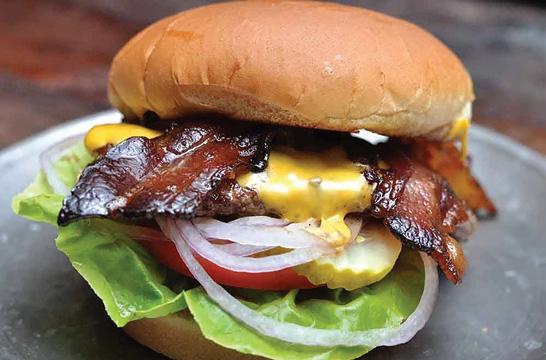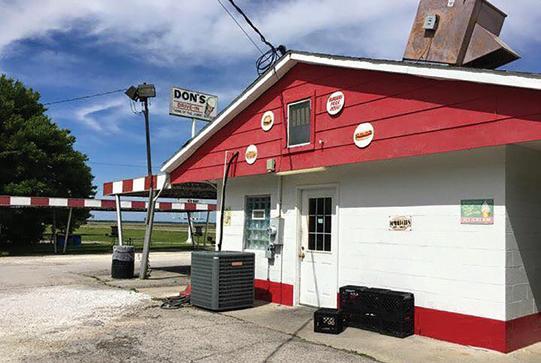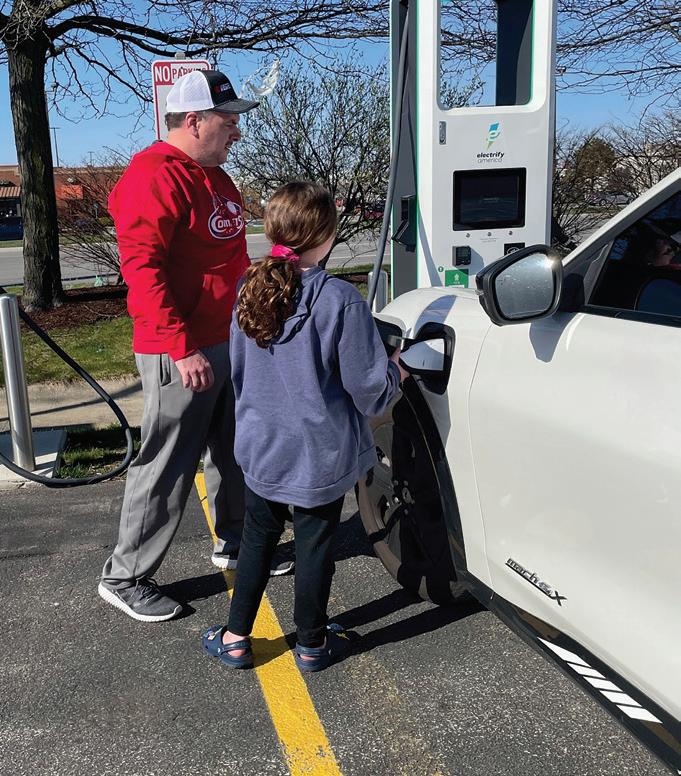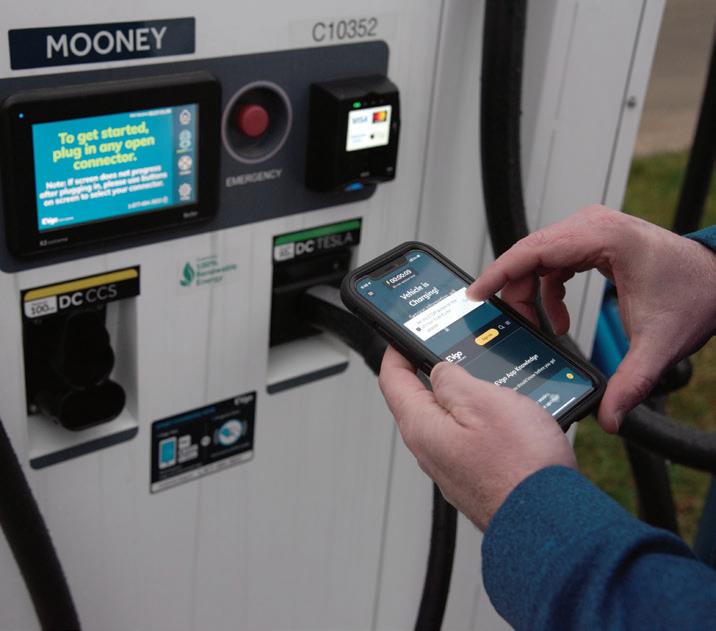




Senior Editor Richard Biever is a rare talent and the lifeblood of Indiana Connection magazine. Here’s more about him, in his own wonderful words.

My role at Indiana Connection is to tell the stories of Indiana’s electric cooperatives and their consumers. As senior editor, I generally write and photograph most of the cover stories. Writing about the people of rural and suburban Indiana, state history and places, and how electric co-ops connect has been an incredibly satisfying career for over 34 years.
Three facts about Richard:
• Some of my favorite things, coincidentally, have their beginnings the year I was born. My two favorite musical artists, Bob Dylan and the Beatles, started recording in 1962; the first season of my favorite baseball team, the New York Mets, was also in 1962.
• Tell City, on the Ohio River, was my dad’s hometown and where I grew up. Perry County is where Abraham Lincoln’s family crossed the Ohio River from Kentucky and settled when Lincoln was a tot. Of course, the land where Lincoln spent a quarter of his life and grew to adulthood became part of Spencer County when it was formed in 1818. That’s still a source of personal pride because Spencer County is where my mother grew up.
• I am passionate about iconic electric cooperative mascot Willie Wiredhand. Willie is the friendly face who’s represented consumer-owned co-op power since 1951. I have done my utmost to keep Willie alive and vibrant as our spokesplug promoting electrical safety and efficiency, and representing co-ops in a light way.
If there’s been a story in the last 34 years you’ve loved, Richard likely wrote it.
Stephanie Groves Editorsgroves@indianaec.org
Win a prize pack of Richard’s favorite things, including a Willie Wiredhand bendy and a Bob Dylan CD!
On the menu: August: Recipes for one pot dinners ready in 30 minutes, deadline June 1. September: Crunchy recipes, deadline July 1. If we publish your recipe on our food pages, we’ll send you a $10 gift card.
Giveaway: Win a prize pack of Richard Biever’s favorite things! Visit indianaconnection.org/talk-to-us/contests or send your contact information to the address below. The deadline to enter is May 31.
Three ways to contact us: To send us recipes, photos, event listings, letters and entries for gift drawings, please use the forms on our website indianaconnection.org; email info@indianaconnection.org; or send to Indiana Connection, 8888 Keystone Crossing, Suite 1600, Indianapolis, IN 46240-4606.
VOLUME 72 • NUMBER 11
ISSN 0745-4651 • USPS 262-340
Published monthly by Indiana Electric Cooperatives
Indiana Connection is for and about members of Indiana’s locally-owned, not-for-profit electric cooperatives. It helps consumers use electricity safely and efficiently; understand energy issues; connect with their co-op; and celebrate life in Indiana. Over 311,000 residents and businesses receive the magazine as part of their electric co-op membership. Member’s cost per issue is approximately 32 cents, plus postage.
CONTACT US:
8888 Keystone Crossing, Suite 1600 Indianapolis, IN 46240-4606 317-487-2220
info@indianaconnection.org
IndianaConnection.org
INDIANA ELECTRIC COOPERATIVES OFFICERS:
Randy Kleaving President
Steve McMichael Vice President
Dr. Richard Leeper Secretary/Treasurer
John Cassady CEO
EDITORIAL STAFF:
Stephanie Groves Editor
Richard George Biever Senior Editor
Holly Huffman Communication Support Specialist
Lauren Carman Communication Manager
Kiley Lipps Graphic Designer
Ashley Curry Production and Design Coordinator
Amber Knight Creative Manager
Mandy Barth Vice President of Communication
ADVERTISING:
American MainStreet Publications
Cheryl Solomon, local ad representative; 512-441-5200; amp.coop
Crosshair Media 502-216-8537; crosshairmedia.net
Paid advertisements are not endorsements by any electric cooperative or this publication.
UNSOLICITED MATERIAL:
Indiana Connection does not use unsolicited freelance manuscripts or photographs and assumes no responsibility for the safekeeping or return of unsolicited material.
SUBSCRIPTIONS:
$12 for individuals not subscribing through participating REMCs/RECs.
CHANGE OF ADDRESS:
If you receive Indiana Connection through your electric co-op membership, report address changes to your local co-op.
POSTAGE:
Periodicals postage paid at Indianapolis, Indiana, and at additional mailing offices.
POSTMASTER:
Send change of address to: Indiana Connection, 8888 Keystone Crossing, Suite 1600, Indianapolis, IN 46240-4606. Include key number.
No portion of Indiana Connection may be reproduced without permission of the editor.







It’s the “Outer Banks or Bust” for the Garner family vacation — a journey of 1,000 miles from Rochester — all on electricity. TJ Garner, from left, wife Ashley, and their kids Mallorey and Maggie made the trip in Fulton County REMC’s EV, a 2022 Ford Mustang Mach-E AWD.


www.harrisonremc.com
CONTACT US
812-738-4115
812-951-2323
Fax: 812-738-2378
Click on “Contact Us” at www.harrisonremc.com.
OFFICE HOURS
7:30 a.m.–4:30 p.m., Monday–Friday
DRIVE-THRU WINDOW HOURS
7:30 a.m.–4:30 p.m., Monday–Friday
LOBBY HOURS
8 a.m.–4 p.m., Monday–Friday
STREET ADDRESS
1165 Old Forest Road, Corydon, IN 47112
MAILING ADDRESS
P.O. Box 517, Corydon, IN 47112
SERVICE INTERRUPTIONS
To report a power outage, please call 812-738-4115 or 812-951-2323.
BOARD OF DIRECTORS
David Poe (Floyds Knobs), President
Brian Koetter (Borden), Vice President

Craig Engleman (Corydon), Secretary/Treasurer
Pat Book (Palmyra)
David Walther (Lanesville)
Darin Duncan (Elizabeth)
C. Todd Uhl (Corydon)
Danny Wiseman (Mauckport)
Roy Zimmerman (Laconia)
LED security light rental; a community solar program; heating and cooling rebate program; surge protection information; home energy seminars; payment via phone, online, e-check, automatic payment plan and budget billing; REMC gift certificates; prepaid billing; and a mobile app with notification options!
The mission of Harrison REMC is to provide a well-informed membership with superior, competitively priced electric and related member service(s), accomplished by highly trained, committed employees. It is further the mission to improve the quality of life of the member-owners by promoting community, economic development and energy efficiency activities.

When we lose electric service, we have come to expect it will be restored in a short time. But when a devastating storm causes major damage over a widespread area, longer outages cannot be helped.
It involves much more than flipping a switch at a substation or pulling a fallen tree off a downed power line. Your local line crews work around the clock resetting poles and rebuilding miles of line, and these arduous tasks need to be completed methodically to be done safely. Sometimes, it requires extra hands of highly trained workers from electric cooperatives in neighboring counties, other parts of Indiana, and even from neighboring states coordinated by specialists from Indiana Electric Cooperatives to come to the aid of your local crews who all work together.
In many cases, resetting or replacing fallen and broken poles also requires calling 811 — the Indiana “call before you dig” service — before crews can dig new holes. This is required to locate other buried utilities along the right-of-way and can add time to the restoration.
Every electric cooperative follows a basic principle when it comes to restoring power: priority is given to the lines that get the most back in service the quickest. Here’s a basic order of repair:
1. TRANSMISSION LINES. These high voltage lines carry electricity from generating plants to substations (or between substations). Since tens of thousands of people could be
served by one transmission line, damage here needs to be taken care of first.
2. SUBSTATIONS. These electrical facilities contain equipment that switch or regulate the voltage of electricity. They lower the voltage from the transmission lines so the electricity can be transmitted through the distribution lines. Problems here can affect thousands of consumers.
3. MAIN DISTRIBUTION LINES. You see these along roadways. They carry electricity from the substations to groups of consumers, like towns or housing developments.
4. TAP LINES. These lines run from the main distribution lines to utility poles and underground transformers outside houses or buildings.
5. INDIVIDUAL SERVICE. These lines run from the transformer on the pole along the road, street or underground box to the consumer’s electric meter on the side of the home or business.
Even after a major storm, report an outage to your electric cooperative. This will help line crews assess the extent of the damage and isolate and repair problems as soon as possible.
By Ryan Strohbeck Engineering/ Operations Manager Harrison REMCElectric service is restored methodically to maintain safety
HVAC TUNE-UP REBATE
RECEIVE A REBATE OF 50% OFF A QUALIFYING HVAC TUNE-UP COST. TOTAL REBATE NOT TO EXCEED $50.
It’s time to schedule your annual pre-season heating, ventilation and air conditioning equipment (HVAC) check-up with a licensed HVAC contractor to ensure your system is operating efficiently. Tune-ups cannot be selfperformed, and the unit must be at least three years old.
The HVAC tune-up rebate is designed for air source heat pumps, geothermal heat pumps and central air conditioning systems. Gas furnaces are not eligible unless part of a central air system.
Please fill out the Tune-Up Rebate application at www. harrisonremc.com/hvac-tuneup-rebate and submit with an itemized receipt showing date of service, total cost for tune-up and a checklist of services performed to Harrison REMC.

TO QUALIFY, YOU MUST OCCUPY THE HOME WHERE THE EQUIPMENT IS INSTALLED YEAR-ROUND (12 MONTHS) AND UNIT MUST HEAT AND COOL THE WHOLE HOME, UNLESS OTHERWISE STATED.
HEAT PUMP REBATES
They heat, they cool, they’re energy efficient and they’re affordable. Four good reasons to install a heat pump in your home. Heat pumps are the most popular way to heat and cool because one piece of equipment does it all. It operates entirely by electricity and offers a high level of comfort and efficiency at low costs. Rebates are available for customers who replace an old heat pump, install a new one or replace a natural gas, propane, oil or wood furnace. There is also a significant rebate for replacing an old air conditioner in a home that has an electric furnace, electric ceiling cable heat, baseboard electric heat or any type of wall electric heaters where the total heating needs of the home are being met by electric resistance heating units.
DUAL FUEL APPLICATIONS
Some believe that two fuels are better than one and combine an air-to-air heat pump with a fossil fuel furnace. In extremely cold weather, a dual fuel heating system selects the fossil fuel furnace for all the home’s heating needs. But for most of our Southern Indiana winters, a dual fuel heating system automatically utilizes the more energy-efficient heat pump to provide your home the heating comfort you desire.
Geothermal heat pumps are the ultimate comfort machine. No system is more efficient or cheaper to operate than the technologically advanced geothermal heat pump system. Together, earth-stored energy and clean, safe electricity offer an efficient and economical way to maintain comfortable heating and cooling year-round.
*Learn more at www.harrisonremc.com/hvac-heat-pump-rebate-form
Water heating usually attributes to around 14% of a typical home’s total energy costs.
A heat pump water heater dramatically reduces electric energy consumption compared to an electric tank style water heater. A standard electric tank style unit will use 4,879 kWh of electricity per year compared to 1,856 kWh of electricity per year for a heat pump model.
For Harrison REMC members, the savings is nearly $302 per year with the current residential electric rate. That translates into an efficiency range of 300% to 500% for heat pump water heaters compared to 90% for a tank style model.
The units get the heat for making hot water from the surrounding air, not from electricity.
Harrison REMC has a $500 rebate for investing in this technology.
Learn more at harrisonremc.com/heat-pumpwater-heater-rebate-form
DID YOU KNOW THAT ELECTRIC OUTDOOR EQUIPMENT HAS SEEN BIG IMPROVEMENTS IN RECENT YEARS? HOW ABOUT A PUSH MOWER THAT CAN TACKLE 3,000 SQUARE FEET IN A SINGLE CHARGE? THAT EXISTS!

Your electric cooperative is offering rebates on electric lawnmowers, leaf blowers, string trimmers, chainsaws, snowblowers, roto-tillers and pressure washers – up to $50 toward the cost of new equipment.
Whether you search online or stop by your local hardware store, we want you to find equipment to keep your lawn well-maintained for years to come. When shopping, look for manufacturers who use lithium-ion batteries as they provide the power you expect and charge quickly. If you need a new push mower, be sure you choose a model that runs on at least 36 volts.
The brand you choose is up to you, as well as where you make the purchase – we trust you know what you need and respect where you want to shop.
Why go electric – beyond the savings this incentive provides? You can say goodbye to gas cans and mixing two-cycle fuel. With electric equipment, all you have to do is keep your battery packs charged.
This incentive will be offered on a firstcome, first-served basis.
Download the application at harrisonremc.com/electric-outdoorequipment-rebate
• Must be a current Harrison REMC residential member-consumer.
• The applicant’s primary address is identified on the application.
• Rebates apply to lawnmowers, string trimmers, leaf blowers, chainsaws, snowblowers, roto-tillers and pressure washers (corded or battery equipment is eligible).
• Equipment must be purchased new; reconditioned or refurbished equipment is not eligible.
• Rebate for qualifying equipment is 50% of the purchase price up to $50.
• Limit (1) rebate per member account.
• Customer must complete and submit application to Harrison REMC.
• Proof of purchase required (receipt or paid invoice).
• Completed rebate application and documentation must be received within 90 days of purchase date.
• Equipment must be purchased between Jan. 1 and Dec. 31, 2023.
• Equipment must have a minimum oneyear warranty.
• Lawnmowers must have a minimum of 36 volts.
• Applications are processed on a first-come, first-served basis while funds are available.
• Rebates may take up to 6 weeks from receipt of the application by Harrison REMC to process.
• Hoosier Energy has full discretion over the rebate and reserves the right to modify the program at any time.
Thank you to everyone who came to see the Easter Bunny at Harrison REMC! More than 100 children attended.

We wanted to share a picture of Logan; he is the son of Blake and Chelsey Bohnert of Corydon. He enjoyed his time with the bunny!
The office will be closed Monday, May 29, for Memorial Day. The employees and directors wish all members and their families a safe holiday.


It may not have happened yet, but sooner or later, you’re going to see electric vehicle charging stations popping up where there were none before.

When they do, odds are it will be part of the National Electric Vehicle Infrastructure (NEVI) program that was created by the passage of the Bipartisan Infrastructure Law in late 2021.
In a plan that has received approval from the Federal Highway Administration, the Indiana Department of Transportation is investing nearly $100 million to build an electric vehicle charging network at strategic locations across the state of Indiana over the next five years.
The NEVI program means that the Indiana Department of Transportation will contract with partners to build Level 3 DC Fast Charge charging stations along Indiana’s federally designated alternative fuel corridors (AFCs). Those consist of I-64, I-65, I-69,
I-70, I-74, I-80, I-94, I-265, I-275, I-465 and I-469.
This will feed into a national initiative to create a network of at least 500,000 reliable chargers across the United States to help support the growing adoption of electric vehicles.
NEVI funds must be invested in DC Fast Charge charging stations that are compliant with federal guidelines. Some of the primary requirements are that each station must have at least four ports that can charge simultaneously, be located every 50 miles along an AFC — less than one mile from an exit or intersection — and be accessible to the public 24 hours a day.
Indiana’s plan will result in at least 44 charging stations across the state. Once completed, every Hoosier should be within 40 miles of a NEVI-funded charging station. Locations are to be determined with federal guidance and a datadriven approach based on electric vehicle miles traveled, EV adoption
rates and growth models. Existing and planned stations as well as electric grid capacity are among other factors to be considered while promoting convenient usage by passenger EVs, along with mediumand heavy-duty vehicles.
The NEVI program will also fund 80 percent of the installation of EV charging stations along with up to five years of operation and maintenance. The remaining 20 percent of costs are to be funded by site owner-operators from whom the state of Indiana expects to seek proposals by mid-2023, with the installation of charging stations beginning in 2024.
by Chelsi Jackson Energy Advisor Henry County REMC

Fountain County is named for James Fountaine (1757–1790), an officer who served in the American Revolutionary War and the Northwest Indian War. Fontaine was from Virginia and began a military career at an early age. After the Revolutionary War, he moved to Kentucky, where he served as major.
He was killed Oct. 22, 1790, in a battle with the Miami nation, led by Little Turtle, near where the St. Joseph River and St. Marys River merge to form the Maumee River, near modern Fort Wayne.

The Wabash River defines half of Fountain County’s shape, forming the northern and western sides. And while the state song, “On the Banks of the Wabash, Far Away,” was written by Paul Dresser, who grew up downstream in Vigo County, the bridge over the Wabash River at Attica bears Dresser’s name.
George Dewey Hay, the founder of the Grand Ole Opry, is one notable native of Fountain County. He was born in Attica in 1895.
After World War I, Hay worked in radio in Chicago before moving to Nashville, where he started the original Grand Ole Opry radio program, from which the country music stage show of the same name evolved.
Hay died in 1968 and was honored as a Sagamore of the Wabash in 1988.
Named after the road it is situated near, Old 55 Distillery (Old55Distillery.com) is an awardwinning family business in Newtown offering whiskey and bourbon made from locally sourced grains, plus a tasting room and facility tours.

FOUNDED: 1826
NAMED FOR: James Fountaine
POPULATION: 16,351 COUNTY SEAT: Covington
INDIANA COUNTY NUMBER: 23
I just wanted to call and say that I just read the March Indiana Connection, and this is the best one I’ve ever read. The story about Hunter Smith is inspiring and the recipes were wonderful, and I never do anything like this, but I just think you guys needed to know that whoever wrote the article with Hunter Smith in it did an excellent job.
DEBBIE THOMPSON
Via telephone
Mr. Biever,
That was not only a beautiful story, but also beautifully written.
SUZETTE RABER
Via email
Our Marketplace offers maximum exposure for your business or organization at a minimal cost. Please contact Cheryl Solomon, 847-749-4875 or cheryl@amp. coop, for other small business advertising opportunities in Indiana Connection.
We know how to find all water leaks underground. Call us!



812-987-4119
www.WhatsBelow.com


If you’re looking for a dining experience with a hint of nostalgia, consider cruising to one of Indiana’s drive-in restaurants. Jesse G. Kirby is credited as the originator of the drive-in concept in the United States, and he founded Kirby’s Pig Stand in the early 1920s in Dallas, Texas. Over the next decade, the trend spread throughout the country, and the concept of ordering food and having it delivered to your car became more common as families began owning automobiles.

Triple XXX was Indiana’s first drive-in, and it opened in West Lafayette in 1929. The restaurant still serves its famous frosty root beer today — although the company no longer employs carhops. Pull in to Triple XXX (2 N. Salisbury St., West Lafayette), or one of these other local standouts, the next time you’d like to enjoy a tasty blast from the past.

As the name suggests, hot dogs are the name of the game at this spot. You can wash down your dog with a milkshake or a flavored fountain drink and pick up a branded T-shirt while you’re there. You’ll receive 10% off your order if you come to the restaurant wearing a Mr. Weenie shirt!


Featuring an authentic intercom system and food delivery by carhops, Don’s Drive In has been in business for 45 years. It’s the place to order one of their ice cream “flurries” swirled with your favorite candy, as well as root beer floats, juicy burgers and fries. The restaurant is cash only, so come prepared.
Opened in 2014, The MUG is owned by Chris Baggot, who also heads up Tyner Pond Farm, a regenerative farm with grass-fed beef and pastureraised chicken and pork. The quality of meat shines through in their offerings, making their hamburger and pork tenderloin two must-try options.

Strawberry Fields may be forever — at least in some of our Beatle-inspired minds — but the juicy red morsels of late spring and early summer are fleeting. Be certain not to miss out on these first fruits of the season by visiting a strawberry festival near you.


All around Indiana, festivals featuring strawberries kick off summer by bringing communities together for good times, good treats and often, good causes. Here are some festivities to check out around the

May 26 | 11 a.m. until sold out, EDT
Johnson County Courthouse lawn, Franklin
Strawberries, shortcakes, ice cream and whipped topping are the main attraction, but the festival offers much more. Food vendors will be open around the courthouse square, and there will be a car cruise-in and bluegrass music from 7-9 p.m.

Discoverdowntownfranklin.com/strawberries-on-the-square
Friday, June 9 | 11 a.m.-10 p.m.
Saturday, June 10 | 10 a.m.-10 p.m.
Sunday, June 11 | 10 a.m.-4 p.m.
Historic Lane Place, Crawfordsville
Each June, Crawfordsville and Montgomery County residents come together to create the largest local event of the year, the Crawfordsville Strawberry Festival. The strawberry-themed festival features food, fun, arts & crafts and topnotch entertainment for all ages.
Crawfordsvillestrawberryfestival.com
June 4 | Noon-4 p.m., EDT
St Joseph Catholic Church, 410 S. Race St., Princeton
Join in this fellowship and community event featuring all things strawberry. Includes outdoor food, kid’s games, a dunking booth, basket raffle, games of chance and a barbecue meal (11 a.m.-2 p.m.).

Facebook.com/ events/5979258855515484
June 10-11, 17-18, 24-25 Saturdays 8 a.m.-7 p.m., Sundays 8 a.m.-6 p.m.
Johnson’s Farm Produce, 8960 E. Ridge Road, Hobart
Fun Farm Weekends include a variety of delicious strawberry treats and activities for kids. In addition, the $12 admission fee includes access to the “UPICK” fields and wagon rides. Johnsonsfarmproduce.com/strawberry-festival
Please check each event’s website or Facebook page before attending, as dates/information may change.


Veronica Sellers, Charlestown, Indiana
1 box yellow cake mix
1⅓ cups orange juice
4 eggs, separated
1½ teaspoons grated orange peel
¼ teaspoon cream of tartar
1 cup plus ¼ cup sugar, divided
2 cups whipping cream
2 pints fresh strawberries, washed and tops removed
In a mixing bowl, combine dry cake mix, orange juice, egg yolks and orange peel. Beat on medium speed for 4 minutes. Pour into two greased and floured 9-inch round baking pans; set aside. In a mixing bowl, beat egg whites and cream of tartar on medium speed until foamy. Gradually beat in 1 cup sugar, a tablespoon at a time, on high until stiff glossy peaks form and sugar is dissolved. Spread the meringue evenly over the cake batter. Bake at 350° F for 35 minutes or until meringue is lightly browned. Cool in pans on wire racks (meringue will crack). Beat whipping cream until stiff peaks form. Mash ½ cup of strawberries with remaining sugar; fold into whipped cream, adding powdered sugar to taste. Loosen edges of cakes from pans with a knife. Using two large spatulas, carefully remove one cake to a serving platter, meringue side up. Gently spread the top of the cake with about half of the cream mixture. Slice the remaining berries; arrange half the berries on top of cream mixture. Repeat layers.

Marilles Mauer, Greensburg, Indiana
3 cups flour
1 teaspoon baking powder
1 teaspoon salt
1 cup butter
1¼ cups sugar
3 eggs
3 tablespoons strawberry
preserves
Juice and zest of 1 lemon
1 teaspoon vanilla extract
8 drops red food coloring
⅔ cup finely chopped strawberries
Preheat oven to 375° F. Line baking sheet with parchment paper. In a medium bowl, whisk together flour, baking powder and salt and set aside. In a large bowl, mix butter and
sugar on medium-high speed until lightened in color, about 3 minutes. Add eggs one at a time, mixing well after each one. Add the strawberry preserves, lemon juice and zest, vanilla extract and red food coloring and mix until incorporated. Scrape down the sides of the bowl and mix once more. With the mixer on low, begin adding the dry ingredients a little at a time until everything is added and blended. Add the strawberries and mix on low until incorporated. Scoop out dough by generous tablespoons and put on prepared baking sheet, spacing about an inch apart. Bake for 10-12 minutes, then cool on a wire rack before serving.

Patricia Zobrist, Knox, Indiana
2 (10-ounce) bags of frozen strawberries, thawed
2 (6-ounce) cans frozen pink lemonade concentrate, thawed
2 (2-liter) bottles of ginger ale, chilled
1 pint fresh strawberries, washed, stems and leaves removed, and sliced
Add frozen strawberries to a blender and blend until pureed. Pour lemonade into a punch bowl and stir in processed berries. Add ginger ale and stir, then sprinkle in the fresh strawberries. Serve immediately.

Do you recall all the safety rules you were taught about refueling when you first learned to drive? Things like: shut off the engine; don’t smoke; don’t leave the pump unattended; and don’t overfill.
If you are among the growing number of drivers sliding in behind the wheel of an electric vehicle, different “refueling” considerations apply.

The most basic electrical safety lesson is that electricity and water don’t mix. However, EVs and their charging stations are designed to handle whatever Mother Nature throws your way, be it dust or rain. That being said, there are precautions to think about when charging an EV, whether you are in your garage or at a public charging station.
“You might not have to worry about spilling gasoline or setting off an explosion at the pump,” said Jon Elkins, vice president of safety, training and compliance at Indiana Electric Cooperatives. “But, just as when you use anything electric, there are a few things to keep in mind.”
Using a Level 1 charger plugged into your garage’s 120-volt/15-amp outlet is the easiest way to charge your vehicle, though it is the slowest. Always use the charger provided by the vehicle’s manufacturer. Before you plug into any electrical outlet, have a qualified electrician inspect and verify the electrical system (outlet, wiring, junctions and protection devices) for heavy-duty service according to your vehicle’s owner’s manual.
Check the electrical outlet and plug while charging and discontinue use if
the electrical outlet or plug is hot, then have the electrical outlet serviced by a qualified electrician.
In addition, always follow the manufacturer’s guidelines when charging. Some of the most common guidelines are:
• Do not use extension cords, multioutlet power strips, surge protection strips or similar devices.
• Do not use an electrical outlet that is worn or damaged, or one that will not hold the plug firmly in place.
• Do not use an electrical outlet that is on a circuit with other electrical loads.
The Level 2 electric vehicle charger uses 240 volts and 20 to 40 amps. This will recharge the car more quickly. You will probably need to have a qualified electrician install the charger and a separate service and plug at your home, similar to the 240 service for an electric range, water heater or clothes dryer.
Before using a public charger, always inspect it first to make sure it doesn’t appear damaged. EV charging stations are designed so the cable remains de-energized until it’s connected to the port on the vehicle. Once connected, the vehicle starts communication with the device, conducting measurements to determine everything is safe and working properly, and only then will it begin the flow of energy.
Switching over to an electric vehicle allows you to “fill ’er up” with kilowatts at a fraction of the cost of gasoline. But just as fuels come as gas, diesel, or E85, or in different octanes, electric vehicles have three general types of chargers. GoElectricDrive.com, which promotes EV awareness, has outlined the three currently commonly used.
Level 1:
Charger uses a standard 120-volt outlet. All drivers can charge their EV at Level 1 at home, which requires no extra equipment or installation. On average, a full charging time is about 8 hours — but varies by model. Consult the automaker’s website for more information.
Level 2:
Charger uses a 240-volt outlet. Homeowners may decide to install a charging station — also known as Electric Vehicle Supply Equipment (EVSE) — in their home. This requires professional installation of an outlet type commonly used by large appliances like electric ranges and dryers. There are also many Level 2 chargers across the United States in public areas. On average, full charging time varies from 2 to 6 hours.
Level 3:
These “DC Fast Charge” networks provide about 80 percent of a vehicle’s potential battery power in about 15 minutes. Though historically reserved for commercial and industrial settings, they are becoming increasingly accessible for use in charging passenger vehicles.
Motorists have long been told we were on a journey to a greener place. Just around the bend was a new world where electric vehicles would easily merge alongside gas-powered vehicles. But for decades, as we rounded the curves, topped hills and traveled long stretches, we passed untapped power lines. And from the back seat of America came the dispirited plea, “Are we there yet?”
At last, after false starts, dead ends and detours, the electrification of transportation is becoming reality.
To that point, TJ Garner, chief operating officer at Fulton County REMC in Rochester, accepted a challenge from Indiana Connection and his employer to take his family on spring break in the co-op’s electric car. This was more than just a short jaunt in the 2022 Ford Mustang Mach-E AWD.
Garner, wife Ashley, and their two daughters were heading to Rodanthe on North Carolina’s Outer Banks. That’s a two-day drive of just over 1,000 miles. Before leaving, Garner carefully charted the trip to locate public charging stations all along the way.

EVs are expected to fully merge into the mainstream by the early 2030s. And, some orange-coned construction zones for electrical infrastructure will need to pop up. But when kids in the backseat of an EV on a long trip start asking, “Are we there yet?,” as kids have asked probably since the days of the Conestoga wagons crossing the dusty plains, that’ll be the sign that EVs as mainstream transportation have arrived.
On the next four pages, follow the Garner family’s “EV travelog” and “TJ’s takeaways” for anyone considering a similar journey.
The car is packed with four suitcases in the back hatch; what was left for a week on the Outer Banks is shoved in the “frunk” (the front trunk of an electric vehicle where the engine is normally located for gas-powered cars). The battery is charged to 100% — for now.
This trip is going to take me out of my “if it isn’t half full, it’s empty” mentality. At a couple of points, we’ll be putting the estimated 312-mile battery range of the REMC’s Ford Mustang Mach-E to the test more than my comfort range normally likes, especially as we get into the mountains of eastern Tennessee and western North Carolina.
After a short first leg down U.S. 31, we arrived at the charger at 67% of charge. Adding only 13% to the battery did not take long. Since it was cold and blustery outside, Ashley and the girls just stayed in the car. After the battery charges to 80%, the kW input really drops off, and it’s almost a waste of time to add more, as long as you have enough at 80% to get to your destination or the next charger.
Out of Indiana and into Ohio: With the seat warmers on and the girls snuggled up in blankets, we arrived at the EVgo station where there were three chargers. Two were 50 kWs, the other was a 150 kW. The faster one was being used when we arrived, so I pulled up to one of the slower ones and plugged in. After I was plugged in for all of three minutes, the car at the faster charger left, so I switched. This charge of about 30 minutes took the car’s battery from 29% to 80%. At the charger, the guy next to us was charging his Kia and admiring the Mustang. I told him about the 1,000-mile trip we were on. He said, “You must be braver than me.”
Into Kentucky: All those horse farms we passed along I-75 seemed fitting since I was driving a Ford Mustang EV. The weather changed, and the sun came out. The temperature jumped up about 20 degrees. The car’s built-in navigation system picked up on this change just north of Lexington. We arrived at the Electrify America charger with 51%. Plugging into the 150 kW charger got us back up to 80% in 20 minutes. At this station, we had the only car parked at any of the chargers.
The car needed one last charge to get us to our destination of the day — Asheville, North Carolina. We arrived at the Electrify America station this time with 38%. Three cars were charging at this stop. The car suggested we charge to 84%, but the charge slowed down so much after 80% that I couldn’t wait any longer. After 25 minutes, we were on the road again. Upon leaving, the navigation system said we should arrive at the hotel we were staying for the night with 25% battery remaining.
Day 2 of the trip started with me leaving the family at the hotel and heading to the Electrify America station next to the hotel. The charger area was busy for being a little before 8 a.m. I was able to get the last spot in the six-bay station. It took an hour to get me to 80%. Then, it was back to the hotel to get the girls and back out onto I-40 heading east.
The so-called “range anxiety” never affected me in the Mustang … until I missed my exit and had to drive all over the state of North Carolina to get back on the right path. As the battery’s percentage kept dropping, my anxiety kept increasing. We finally arrived at the hotel with 12% battery left. I’m sure this would not bother many people, but as a new EV driver, I was in panic mode. Luckily, the hotel was a block away from an Electrify America station. That was intentional, on my part, in planning the trip.
Jamestown was planned out perfectly from the car’s onboard navigation. It brought us to a charger that was a half mile off the path. That would have been perfect — if I could have gotten the charger to connect. The app needed for this charger at Shell Energy was one that I did not have in my rolodex of charging apps on my phone, and for some reason I could not download one. So, after messing with it for a few minutes, I looked for the closest one down the road. We had to go about 10 miles out of the way, but it was at a nice little grocery store. This was a 45-minute charge to 80%, and off we went.
The final stop before Rodanthe was at Edgecombe-Martin County Electric Membership Corporation in Tarboro. This charger was one of my favorite charger spots. The charger was in the parking lot of the cooperative. Though there was no bathroom (the cooperative office was closed on this Saturday afternoon) and no snacks, what I liked about this location was the empty parking lot. Every other charging station we used was in a busy parking lot. The girls got to get out and run off some energy without any worry of traffic. An hour on the dot, and 80% charged, we were ready for the beach.
We arrived at the beach in the late afternoon with about 80 miles left of range. I immediately plugged the car into a 120volt wall outlet at the vacation home we are renting with my parents, my two sisters and their families — 14 of us with ages ranging from 3 to 72. My Ford app said the Mustang would be fully charged in four days, Tuesday at 11 p.m. There is a public charger down the road that I hope works because it’s the only one faster than the wall outlet for 90 miles.

Day 3
For the journey home, the Mustang had charged to 98% on the car’s portable charger plugged into a 120-volt outlet at the beach home. Its range read 245 miles. We said goodbye to the rest of the family and headed out just before 8 a.m. We essentially retraced our route. We made two stops in North Carolina before reaching Asheville for the night. Nearing Asheville, we hit a headwind of 40 mph. That, with the mountains, made the range drop fast. I got a little nervous when the car’s “low battery” alarm dinged at 21%. It dinged again at 11%. But, we made it to the hotel, and I recharged at the same station I used on the way to Rodanthe.
We left the hotel at 7 a.m. with 80% charge. Stops included stations just east of Knoxville, Tennessee, and the two in Kentucky where we had stopped on the way down. The last gave us enough juice to skip the stop in Ohio.
Back home again in Indiana, the car’s navigation took us to an Electrify America station on Indy’s northeast side in Fishers. Mallorey was in charge of hooking up the charger at this stop. She did great!

We arrived home in Rochester that evening with 33% battery left. We unpacked, and I dug out the portable charger to charge the car overnight so it was ready to go in the morning — when it was back to work for the Mustang and me.
I was skeptical about taking this trip in the Ford Mustang EV. The farthest I had driven it previously was 96 miles. Even then, I made sure I was fully charged before I left and plugged into the free charger while there. Range anxiety was a big deal to me. After 2,100 miles, here are some things I learned:
• Room for four: I was surprised how much we were able to fit into the Mach-E. No issue with not having enough room for a family of four and all the things needed for a week at the beach.

• Use the Ford: Before the trip, I plotted the route that would give me the most access to chargers along the way. This helped me with my range anxiety. After driving a few hundred miles, I decided to trust the car’s built-in navigation system. It gave me an exact mile range to my next charger. Seeing that the mileage was always less than total miles left on the battery really did keep me from worrying about not making it to the next charging destination.
• Charge time: The time needed to recharge added about 3.5 hours each way. On the way down, it actually was nice having those extra stops to break it up. On the way back, it seemed longer. But by then, no matter if you’re stopping at gas stations or charging stations, you just want to get home.
• The cost: The big question most folks probably have is “What was the difference in the wallet?” I knew the price of charging along the road had gone up, but I had no idea it was now an average of 45 cents per kWh (the average kWh costs Indiana residential electric consumers about 17 cents). If I drove those same miles and was able to charge at my home rate, I would have spent only $75. As it was, we spent $268 for 596 kWhs I had to buy along the way. If we would have taken our Ford Explorer that gets 25 mpg, we would have spent around $294 for the 2,100 total trip (using an average of $3.50 for a gallon of gas). So, there was some savings on fuel cost, but not a lot. This trip was never about saving time or money. Like any family trip, it was about making memories. Our girls will have many from our EV journey.

EVs have evolved since first arriving in car showrooms over a decade ago. Yet, as with any new technology, myths based on earlier perceptions persist. Here are three common ones.
Source: EPA.com

MYTH: Electric vehicles don’t have enough range to handle daily travel demands.
FACT: EV range is more than enough for typical daily use.
A typical U.S. household’s daily travel is about 50 miles; only 15% of households travel over 100 miles on a typical day. Most EV models go above 200 miles on a fully-charged battery, with nearly all new models traveling more than 100 miles on a single charge.
Range estimates for specific EVs are available from the “Find a Car” tool on www.fueleconomy.gov — click on the car you are interested in and check out the “EPA Fuel Economy” information in the table.
MYTH: There’s nowhere to charge.
FACT: Most EVs can be plugged into the same outlet as a toaster! When you need to charge fast on the road, you’ll find over 51,000 stations in the U.S. available to the public. Many people can meet their driving needs by plugging in only at home with a standard 120-volt outlet or a dedicated 240-volt system. For those who live in apartments or condominiums, EV charging stations are becoming a common amenity.
Access to EV charging will increase significantly in the coming years as charging infrastructure is built out along highways and in communities.
MYTH: EVs are not as safe as comparable gasoline vehicles.
FACT: EVs must meet the same safety standards as conventional vehicles.
All light-duty cars and trucks sold in the United States must meet the Federal Motor Vehicle Safety Standards. To meet these standards, vehicles must undergo an extensive, long-established testing process, regardless of whether the vehicle operates on gasoline or electricity. EV battery packs must also meet their own testing standards. Moreover, EVs are designed with additional safety features that shut down the electrical system when they detect a collision or short circuit.


Distributed Energy Resources (DERs) are, in general, small-scale energy resources that provide electric capacity or energy close to where they are used. DERs are an evolving part of the utility landscape for consumers — and for Hoosier Energy, as well.
In an effort to maximize the benefits of technologies such as battery storage, electric vehicle charging, smart devices and more, a DER Strategy Subcommittee was formed in September 2022 and has been gathering momentum ever since.
The 13-member subcommittee is comprised of six member cooperative representatives, five Hoosier Energy representatives and a pair of facilitators from Hoosier.
The range of diversity within the committee, from energy advisors to engineering, marketing and customer service, allows for the consideration of multiple perspectives as the committee looks to find its footing.
The roots of this new committee are in an old group — the Demand Side Management Subcommittee. The work the previous committee did and the recommendations it made, based on internal
program statistics, member cooperative survey data and the vote of the committee members, ultimately led to the formation of this DER Subcommittee. Now, the focus is on Hoosier Energy’s strategic priorities in distributed energy resources and integrated planning.
Discussions focus on the future, not just of the utility industry, but on how cooperative members can continue to find value and satisfaction in the programs offered.
Those programs, whether currently in place or planned for the future, cover everything from educational resources to emerging technologies.
Whether it’s electric vehicles or smart thermostats, distributed energy resources will only continue to become a bigger part of the future, and Hoosier Energy’s DER Subcommittee is ready to grow with them.
Most gardeners would agree that tomatoes are the most popular crop for home growing. But what gardeners can’t agree on is what tomato is considered the best, since taste is such a personal matter.

The diversity of cultivars available makes it easy for anyone to grow tomatoes even if all you have is a pot on the patio. Burpee seed company introduced the first F1 hybrid tomato “Big Boy” in 1949. Since then, plant breeders have introduced thousands of hybrid tomatoes. Modern hybrids bring disease resistance, cold tolerance, nematode resistance and hybrid vigor as well as a dazzling range of colors, shapes and sizes.
There are several ways to classify the wide array of tomatoes that are so popular among gardeners today. First, you can group them by fruit size and shape. From small to large, there are: currant, cherry/grape, salad/cocktail, plum, pear, standard slicing and beefsteak types.
Second, you can group tomatoes by the amount of time it takes for the plants to mature fruit for harvest. Seed packets will list the expected length of time to maturity in the number of days, but in general, cultivars are classified as early, midseason or late-maturing. Early cultivars take 55 to 65 days from transplanting to the garden. Midseason is 66 to 80 days. Late types are those needing more than 80 days from transplanting.
Third, you can group tomatoes by the plant’s growth habit: determinate or indeterminate. Determinate plants tend to grow their foliage first, then set flowers that mature into fruit if pollination is successful. The fruit
By Rosie Lernertends to ripen on a plant at about the same time. Indeterminate tomatoes start out by growing some foliage, then continue to produce foliage and flowers throughout the gardening season. These plants will tend to have tomato fruit in different stages of maturity at any given time once they start to set fruit.
More recent developments in tomato breeding have led to a wider array of fruit colors. In addition to the standard red ripe color, tomatoes can be creamy white, lime green, pink, yellow, golden, orange, purple or nearly black. The pink and yellowish types have mistakenly been referred to as lowacid tomatoes, but in fact, these types are just higher in sugar, which makes them taste less acidic.
Whichever cultivars you choose to grow, note that all tomatoes are warmseason crops, meaning you should wait until after the date of average last frost in your area before you plant them. Usually, that is mid- to late April in southern Indiana and early to midMay in northern Indiana.
Q:Every year I try to start tomato seeds in the house, but they do not grow strong stems. They’re usually wispy and fall over with no other leaves but the two top ones. Hope you can help me.
 — Carol Leskiw, DeMotte, Indiana
— Carol Leskiw, DeMotte, Indiana
A:Weak, spindly tomato seedlings are most likely the result of insufficient light. This is true for most all vegetable plant seedlings. If possible, move the seedlings to brighter light as soon as they emerge. You might consider using artificial lighting geared for plant growing if needed.
For more information about growing transplants for the garden, check out the following article from Purdue Extension: www.purdue. edu/hla/sites/yardandgarden/ ardeners-start-your-seeds/
Longtime Indiana Connection contributer B. Rosie Lerner, a Tipmont REMC consumer, is a retired Purdue Extension consumer horticulturist. Questions about gardening issues may be sent to “Ask Rosie,” Indiana Connection, 8888 Keystone Crossing, Suite 1600, Indianapolis, IN 46240-4606, or use the form at IndianaConnection.org.
The United States' national bird is the bald eagle; our national mammal is the American bison. It’s time for us to give the beaver its due and declare the waterway engineer as our official national rodent.
Some may disagree, saying we already have the groundhog. Granted, the pasture poodle even has its own day, Feb. 2, delegated as Groundhog Day. But the notion our meteorological misfit forecasts the weather is bogus: There are always six more weeks of winter! While our bald eagle is inspirational and the bison represents strength, neither had the impact that the American beaver did in forming and developing our nation.
Early in the history of our country, the beaver was highly sought after for its luxurious pelt. Millions of hides were exported to England and Europe. The pelts were shaved for their hair, which was used in the manufacturing of felt for the top hat industry. “Beaver” hats were the rage.
Trappers and fur traders set out from the East Coast colonies and Canada to follow the “brown
gold” of beaver pelts, which led to the rapid demise of the animal in the Midwest. By 1810 or 1820, the beaver had been hunted and trapped into local extinction. As beaver colonies disappeared, trappers, fur traders and explorers continued traveling west and north. News of their finding fertile valleys, open plains, mineral deposits and vast timber resources attracted the attention of settlers looking for a better life. Wagon trains soon followed.
Reintroductions of beavers in Indiana began in 1935 and continued through the first open trapping season in 1951. The initial reintroduction was done with animals purchased from Michigan and Wisconsin and released on Jasper-Pulaski and Kankakee state game preserves. As the animals reproduced, they were live-trapped and moved to other parts of the state. By 1986, beavers were found in 43 Indiana counties, and they are now found throughout the state.
While some might consider beavers to be pests, they create wetlands by constructing dams and forming ponds that provide

habitat for other species including fish, mammals, waterfowl, songbirds, amphibians and insects. The wetlands they engineer also improve water quality and mitigate drought and flooding conditions downstream.
Canada has made the riparian rodent one of its national symbols. In my opinion, it’s time we proclaim it as our national rodent! It even has a great motto: “Busy as a beaver.”
JACK SPAULDING
is a syndicated state outdoors writer and a member of RushShelby Energy.
Readers can contact the author by writing to this publication, or by email to jackspaulding@hughes. net. Spaulding’s books, “The Best Of Spaulding Outdoors” and “The Coon Hunter And The Kid,” are available from Amazon.com as paperbacks or Kindle downloads.


